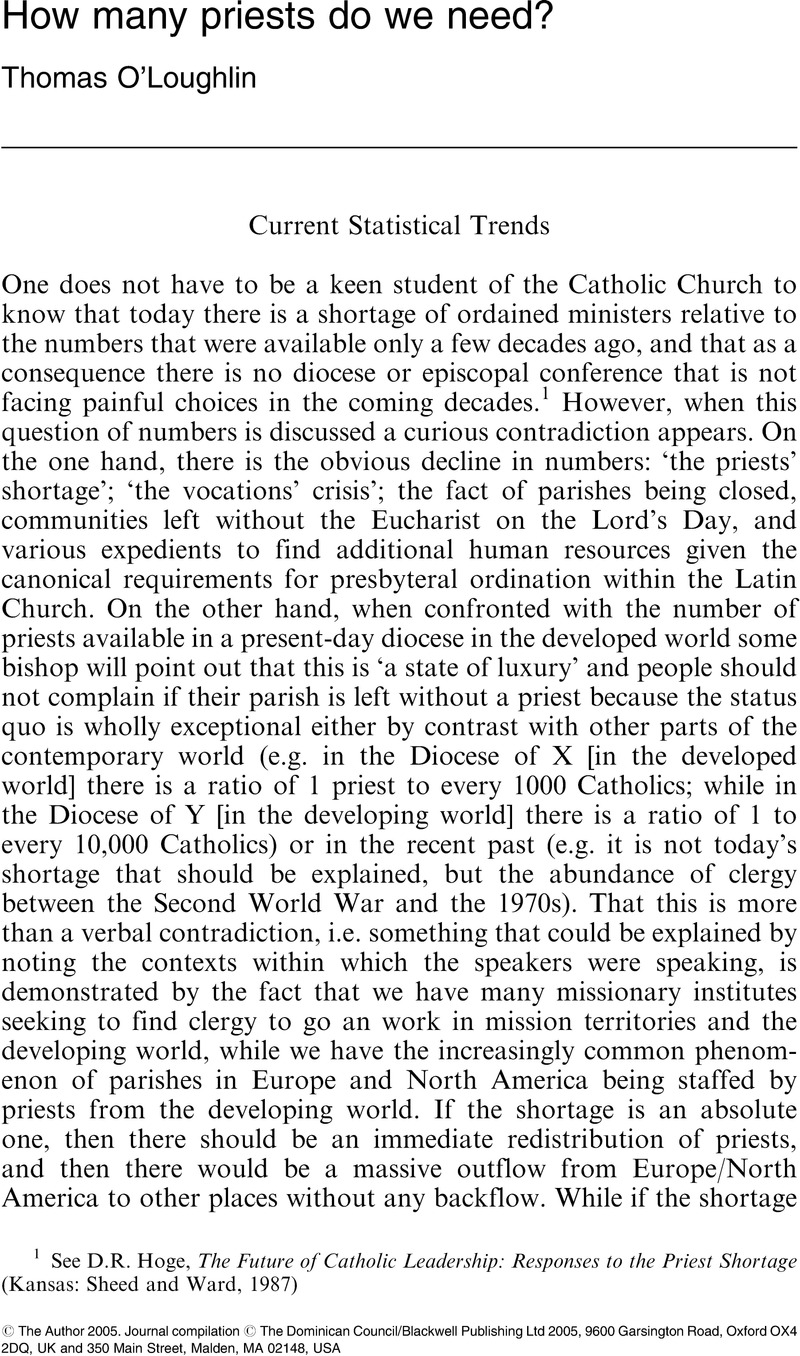Article contents
How many priests do we need?
Published online by Cambridge University Press: 01 January 2024
Abstract

- Type
- Original Articles
- Information
- Copyright
- Copyright © The Author 2005. Journal compilation © The Dominican Council/Blackwell Publishing Ltd 2005, 9600 Garsington Road, Oxford OX4 2DQ, UK and 350 Main Street, Malden, MA 02148, USA
References
1 See Hoge, D.R., The Future of Catholic Leadership: Responses to the Priest Shortage(Kansas: Sheed and Ward, 1987)Google Scholar
2 This mode for approaching apparently contradictory phenomena is that of Kuhn, T.S., The Structure of Scientific Revolutions(Chicago: University of Chicago Press, second edition 1970), pp. 52–76Google Scholar.
3 Although in these cases there is a long debate as to whether they belong to the ‘power of orders’ or the ‘power of jurisdiction’ since they flow from the Power of the Keys which could be given to anyone with the suitable papal legated authority; however, because this sort of canonically driven systematics has its own specialist adepts who always know even more arcane rules governing their movement of theological objects I feel I should say no more about this.
4 Canon 905.
5 See Vogel, C., ‘La Multiplication des Messes Solitaires au Moyen Age: Essai de Statistique,’Revue de Sciences Religieuses 55(1981) 206–213CrossRefGoogle Scholar.
6 See Meehan, A.B., ‘Bination,’Catholic Encyclopedia(New York: Robert Appleton Company, 1907), vol. 2, pp. 568–9Google Scholar.
7 The rubrics always assumed that the server would carry out the actions required and answer, however, since a woman could never carry out the actions but could answer ‘from the rails’ this possibility was allowed by the canonists and rubricians as emergency exception; cf. O’Connell, J., The Rite of Low Mass(London: Burns Oates and Washbourne, 1942), pp. 212–3Google Scholar.
8 Thomas Aquinas, Summa theologiae 3, 83, 5 ad 12.
9 For example, the great church of St Sulpice in central Paris is not a normal parish church but the home church of a great religious congregation, and like other large centre city churches was conceived as having a special role within the whole of the city.
10 See O’Loughlin, T., ‘Translating Panis in a Eucharistic Context: A Problem of Language and Theology,’Worship 78(2004) 226–35Google Scholar.
11 See Meier, J.P., ‘The Eucharist at the Last Supper: Did it happen?’Theology Digest 42(1995) 335–51Google Scholar.
12 See 1 Cor 10:17 and 11:25–7.
13 White, J.F. and White, S.J., Church Architecture: Building and Renovating for Christian Worship(Akron, Ohio: OSL Publications, second edition 1998), pp. 2–3Google Scholar.
14 I am indebted to J.‐P. Audet for the notion that each form of eating is related to the size of the group, and that in turn is linked to hospitality (Structures of Christian Priesthood, London: Sheed and Ward, 1967, pp. 167–70Google Scholar).
15 See Turner, V., The Ritual Process: Structure and Anti‐Structure(New York: Aldine de Gruyter, 1995 [first published 1969]), pp. 131–65Google Scholar.
16 Cf. Meier, J.P., A Marginal Jew: Mentor, Message, and Miracles(New York: Doubleday, 1994), pp. 334–7Google Scholar.
17 See Abeti, M., Un’architettura cristiana: per una nuova assembea celebrante(Naples: Luciano, 1998), pp. 61–82Google Scholar.
18 Cf. Woolley, R.M., The Bread of the Eucharist(London: A.R. Mowbray and Co., 1913)Google Scholar.
19 Erickson, J.H., ‘Leavened and Unleavened: Some Theological Implications of the Schism of 1054,’St Vladimir's Theological Quarterly 14(1970) 155–76Google Scholar.
20 Whether or not the western introduction of azymes for the Eucharist was a departure from the tradition is a matter of theological judgement – and the Latin church has used its highest authority to declare on this matter: see Canon 926; however, that introduction was historically without precedent – notwithstanding the ‘historical’ clause in Canon 926; secundum antiquam Ecclesiae latinae traditionem.
21 It should be noted that while many clerics think the idea of a single loaf being actually broken at a celebration is a meaningless suggestion because it would be (a) impractical and (b) that if people had an adequate ‘theology’ of the Eucharist they would not worry about ‘mere symbols’; it should also be noted that a very large proportion of baptised Catholics consider the eucharistic ritual so meaningless as not worth their regular attendance – hence it is at least arguable that it is the separation between the symbolism chosen by Christ and the actual use of those symbols by the church that is part of the problem.
22 See Huels, J.M., ‘The New Instruction of the Roman Missal: Subsidiarity or Uniformity?’Worship 75(2001) 482–511Google Scholar at 494 and 499–501; this article presents the canonical situation regarding Communion sub utraque specie.
23 See Kieckhefer, R., Theology in Stone: Church Architecture from Byzantium to Berkeley(Oxford: Oxford University Press, 2004), p. 22CrossRefGoogle Scholar.
24 Memento, Domine, famulorum famularumque tuarum … et omnium circumstantium …
25 See O’Loughlin, T., ‘The Praxis and Explanations of Eucharististic Fraction in the Ninth Century: The Insular Evidence,’Archiv für Liturgiewissenschaft 45(2003)1–20Google Scholar.
26 See O’Loughlin, T., Celtic Theology(London: Continuum, 2000), pp. 135–6Google Scholar.
- 2
- Cited by




